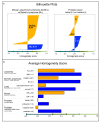Molecular sampling of prostate cancer: a dilemma for predicting disease progression
- PMID: 20233430
- PMCID: PMC2855514
- DOI: 10.1186/1755-8794-3-8
Molecular sampling of prostate cancer: a dilemma for predicting disease progression
Abstract
Background: Current prostate cancer prognostic models are based on pre-treatment prostate specific antigen (PSA) levels, biopsy Gleason score, and clinical staging but in practice are inadequate to accurately predict disease progression. Hence, we sought to develop a molecular panel for prostate cancer progression by reasoning that molecular profiles might further improve current clinical models.
Methods: We analyzed a Swedish Watchful Waiting cohort with up to 30 years of clinical follow up using a novel method for gene expression profiling. This cDNA-mediated annealing, selection, ligation, and extension (DASL) method enabled the use of formalin-fixed paraffin-embedded transurethral resection of prostate (TURP) samples taken at the time of the initial diagnosis. We determined the expression profiles of 6100 genes for 281 men divided in two extreme groups: men who died of prostate cancer and men who survived more than 10 years without metastases (lethals and indolents, respectively). Several statistical and machine learning models using clinical and molecular features were evaluated for their ability to distinguish lethal from indolent cases.
Results: Surprisingly, none of the predictive models using molecular profiles significantly improved over models using clinical variables only. Additional computational analysis confirmed that molecular heterogeneity within both the lethal and indolent classes is widespread in prostate cancer as compared to other types of tumors.
Conclusions: The determination of the molecularly dominant tumor nodule may be limited by sampling at time of initial diagnosis, may not be present at time of initial diagnosis, or may occur as the disease progresses making the development of molecular biomarkers for prostate cancer progression challenging.
Figures




Similar articles
-
Prostate stem cell antigen mRNA expression in preoperatively negative biopsy specimens predicts subsequent cancer after transurethral resection of the prostate for benign prostatic hyperplasia.Prostate. 2009 Sep 1;69(12):1292-302. doi: 10.1002/pros.20973. Prostate. 2009. PMID: 19462463
-
Prognostic value of DNA ploidy, bcl-2 and p53 in localized prostate adenocarcinoma incidentally discovered at transurethral prostatectomy.J Urol. 2006 Dec;176(6 Pt 1):2701-5. doi: 10.1016/j.juro.2006.07.133. J Urol. 2006. PMID: 17085199
-
A 12-gene expression signature is associated with aggressive histological in prostate cancer: SEC14L1 and TCEB1 genes are potential markers of progression.Am J Pathol. 2012 Nov;181(5):1585-94. doi: 10.1016/j.ajpath.2012.08.005. Am J Pathol. 2012. PMID: 23083832
-
Molecular profiling of indolent human prostate cancer: tackling technical challenges to achieve high-fidelity genome-wide data.Asian J Androl. 2012 May;14(3):385-92. doi: 10.1038/aja.2011.147. Epub 2012 Feb 6. Asian J Androl. 2012. PMID: 22306912 Free PMC article. Review.
-
Clinical variability and molecular heterogeneity in prostate cancer.Asian J Androl. 2016 Jul-Aug;18(4):543-8. doi: 10.4103/1008-682X.178852. Asian J Androl. 2016. PMID: 27080479 Free PMC article. Review.
Cited by
-
The roots of cancer: stem cells and the basis for tumor heterogeneity.Bioessays. 2013 Mar;35(3):253-60. doi: 10.1002/bies.201200101. Epub 2012 Oct 2. Bioessays. 2013. PMID: 23027425 Free PMC article. Review.
-
The genes controlling normal function of citrate and spermine secretion are lost in aggressive prostate cancer and prostate model systems.iScience. 2022 May 23;25(6):104451. doi: 10.1016/j.isci.2022.104451. eCollection 2022 Jun 17. iScience. 2022. PMID: 35707723 Free PMC article.
-
Cost-Effective Extreme Case-Control Design Using a Resampling Method.Evol Bioinform Online. 2019 Apr 4;15:1176934319838821. doi: 10.1177/1176934319838821. eCollection 2019. Evol Bioinform Online. 2019. PMID: 30992655 Free PMC article.
-
Co-clinical Analysis of a Genetically Engineered Mouse Model and Human Prostate Cancer Reveals Significance of NKX3.1 Expression for Response to 5α-reductase Inhibition.Eur Urol. 2017 Oct;72(4):499-506. doi: 10.1016/j.eururo.2017.03.031. Epub 2017 Apr 4. Eur Urol. 2017. PMID: 28385453 Free PMC article.
-
Probing the prostate tumour microenvironment II: Impact of hypoxia on a cell model of prostate cancer progression.Oncotarget. 2017 Feb 28;8(9):15307-15337. doi: 10.18632/oncotarget.14574. Oncotarget. 2017. PMID: 28410543 Free PMC article.
References
-
- Bill-Axelson A, Holmberg L, Filen F, Ruutu M, Garmo H, Busch C, Nordling S, Haggman M, Andersson S, Bratell S, Spangberg A, Palmgren J, Adami H, Johansson J. for the Scandinavian Prostate Cancer Group Study Number 4. Radical Prostatectomy Versus Watchful Waiting in Localized Prostate Cancer: the Scandinavian Prostate Cancer Group-4 Randomized Trial. J Natl Cancer Inst. 2008;100:1144–1154. doi: 10.1093/jnci/djn255. - DOI - PMC - PubMed
-
- Bill-Axelson A, Holmberg L, Ruutu M, Häggman M, Andersson S, Bratell S, Spångberg A, Busch C, Nordling S, Garmo H, Palmgren J, Adami H, Norlén BJ, Johansson J. Radical prostatectomy versus watchful waiting in early prostate cancer. N Engl J Med. 2005;352:1977–84. doi: 10.1056/NEJMoa043739. - DOI - PubMed
Publication types
MeSH terms
Substances
Grants and funding
LinkOut - more resources
Full Text Sources
Other Literature Sources
Medical
Molecular Biology Databases
Research Materials
Miscellaneous

